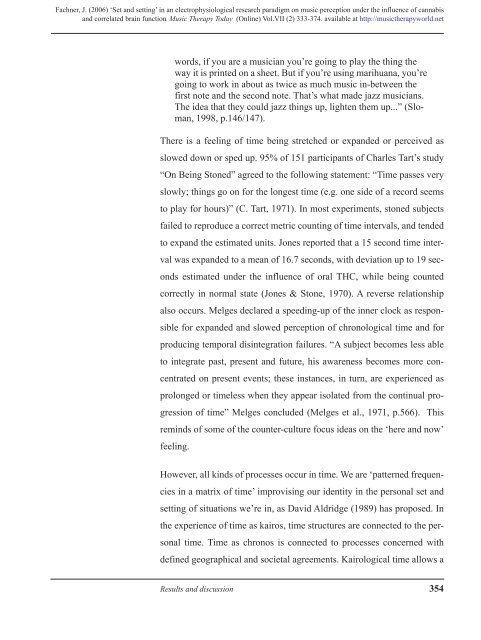Music Therapy Today - World Federation of Music Therapy
Music Therapy Today - World Federation of Music Therapy
Music Therapy Today - World Federation of Music Therapy
Create successful ePaper yourself
Turn your PDF publications into a flip-book with our unique Google optimized e-Paper software.
Fachner, J. (2006) ‘Set and setting’ in an electrophysiological research paradigm on music perception under the influence <strong>of</strong> cannabis<br />
and correlated brain function. <strong>Music</strong> <strong>Therapy</strong> <strong>Today</strong> (Online) Vol.VII (2) 333-374. available at http://musictherapyworld.net<br />
words, if you are a musician you’re going to play the thing the<br />
way it is printed on a sheet. But if you’re using marihuana, you’re<br />
going to work in about as twice as much music in-between the<br />
first note and the second note. That’s what made jazz musicians.<br />
The idea that they could jazz things up, lighten them up...” (Sloman,<br />
1998, p.146/147).<br />
There is a feeling <strong>of</strong> time being stretched or expanded or perceived as<br />
slowed down or sped up. 95% <strong>of</strong> 151 participants <strong>of</strong> Charles Tart’s study<br />
“On Being Stoned” agreed to the following statement: “Time passes very<br />
slowly; things go on for the longest time (e.g. one side <strong>of</strong> a record seems<br />
to play for hours)” (C. Tart, 1971). In most experiments, stoned subjects<br />
failed to reproduce a correct metric counting <strong>of</strong> time intervals, and tended<br />
to expand the estimated units. Jones reported that a 15 second time inter-<br />
val was expanded to a mean <strong>of</strong> 16.7 seconds, with deviation up to 19 sec-<br />
onds estimated under the influence <strong>of</strong> oral THC, while being counted<br />
correctly in normal state (Jones & Stone, 1970). A reverse relationship<br />
also occurs. Melges declared a speeding-up <strong>of</strong> the inner clock as respon-<br />
sible for expanded and slowed perception <strong>of</strong> chronological time and for<br />
producing temporal disintegration failures. “A subject becomes less able<br />
to integrate past, present and future, his awareness becomes more con-<br />
centrated on present events; these instances, in turn, are experienced as<br />
prolonged or timeless when they appear isolated from the continual pro-<br />
gression <strong>of</strong> time” Melges concluded (Melges et al., 1971, p.566). This<br />
reminds <strong>of</strong> some <strong>of</strong> the counter-culture focus ideas on the ‘here and now’<br />
feeling.<br />
However, all kinds <strong>of</strong> processes occur in time. We are ‘patterned frequen-<br />
cies in a matrix <strong>of</strong> time’ improvising our identity in the personal set and<br />
setting <strong>of</strong> situations we’re in, as David Aldridge (1989) has proposed. In<br />
the experience <strong>of</strong> time as kairos, time structures are connected to the per-<br />
sonal time. Time as chronos is connected to processes concerned with<br />
defined geographical and societal agreements. Kairological time allows a<br />
Results and discussion 354

















